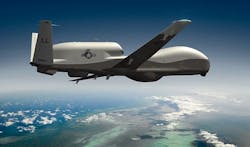Northrop Grumman to fix MQ-4C Triton UAV air-to-air radar before Navy production decision
PATUXENT RIVER NAS, Md., 17 June 2015. U.S. Navy unmanned aircraft experts are asking Northrop Grumman Corp. to correct deficiencies in the air-to-air radar system aboard the MQ-4C Triton maritime patrol drone before making a production decision on the Triton by the end of this year.
Officials of the Naval Air Systems Command at Patuxent River Naval Air Station, Md., announced a $39.1 million contract modification Monday to the Northrop Grumman Aerospace Systems sector in San Diego to enhance and adjust the Triton's air-to-air radar, which is still in development and has not yet been test flown.
The contract calls for Northrop Grumman to make adjustments in the current air-to-air radar subsystem design of the Triton UAV and to demonstrate that the drone's air-to-air radar technology, performance, and manufacturing risks have been mitigated.
Northrop Grumman and its air-to-air radar supplier, Exelis Inc. in McLean, Va., are developing a radar for the Triton that will enable the unmanned aircraft to detect other aircraft in the area for sense-and-avoid functionality, as well as for targeting.
The Triton air-to-air radar is the first of its kind, and has been a challenge for Northrop Grumman and Exelis to size such that it is small and lightweight enough to fit on the Triton UAV, Northrop Grumman officials say.
This order is part of the Triton's system development and demonstration (SDD) phase, part of the Triton research and development that involves mature system development, integration, and demonstration to initial operational test and evaluation (IOT&E) -- the last phase before full production.
Northrop Grumman is developing the MQ-4C Triton, also called the Broad Area Maritime Surveillance (BAMS) UAV, to fly maritime surveillance missions for as long as 24 hours at altitudes of more than 10 miles to enable coverage out to 2,000 nautical miles. The UAV's suite of sensors can detect and classify different types of ships automatically.
The Triton's SDD phase began in early 2008 with a $1.2 billion contract to Northrop Grumman to design and build two Triton UAVs with mission payloads and communications suites; one forward operating base mission control system; one systems integration laboratory; and one main operating base mission control system.
The Triton will be a crucial component of the Navy's 21st century strategy for conducting surveillance of surface ship and submarine traffic in the vast Pacific and other oceans around the globe.
The Triton UAV will work together with the Navy's P-8A Poseidon manned maritime patrol aircraft. The P-8 is a Boeing 737 passenger jet modified for surveillance and anti-submarine warfare (ASW) missions.
Related: Navy to locate mission-control center for fleet of maritime-patrol UAVs at Jacksonville NAS
The Triton's maritime search radar is called the Multi-Function Active Sensor (MFAS), and will provide the UAV with a 360-degree view of a large geographic area while providing all-weather coverage for detecting, classifying, tracking, and identifying points of interest.
MFAS is separate from the Triton's air-to-air radar. The MFAS radar first flew on the Triton during testing last April.
Along with the air-to-air and MFAS radar systems, the MQ-4C also will carry an electro-optical/infrared (EO/IR) sensor that will provide still imagery and full-motion video of potential threats; an electronic support measures package to identify and geolocate radar threat signals; and an Automatic Identification System (AIS) that will detect and track vessels equipped with AIS responders.
In a continuation of the Triton SDD phase, the Navy awarded a $22.4 million contract modification to Northrop Grumman in April 2009 for aircraft wing static and load testing. Following this was $19.7 million contract to Northrop Grumman in September 2010 to perform Triton radar risk reduction flight tests.
story continues below
In May 2012 Northrop Grumman won a $32.8 million modification to develop a logistics management system and switch from contractor logistics support to organic military maintenance. A December 2012 $7.2 million contract modification asked Northrop Grumman to certify the Triton's airborne recorder to National Security Agency (NSA) guidelines.
Then in May 2013 the Navy awarded a $125.3 million modification for Northrop Grumman upgrade Triton software from Windows XP to Windows 7. This week's software-modification contract brings total Navy spending for the Triton SDD phase to $1.3 billion. The Triton should be ready to deploy by 2017.
On Monday's contract modification to correct deficiencies in the Triton's air-to-air radar, Northrop Grumman will do the work in Rancho Bernardo, Calif., and should be finished by December 2016.
For more information contact Northrop Grumman Aerospace Systems online at www.northropgrumman.com, or Naval Air Systems Command at www.navair.navy.mil.

